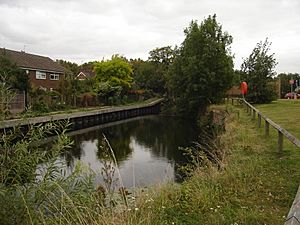Millhead Stream facts for kids
The Millhead Stream is a small waterway in England. It's like a little arm that flows into the bigger River Lea. This stream travels from north to south through the Waltham Abbey area. It also passes right through the place where the old Royal Gunpowder Mills used to be.
History of the Millhead Stream
The Millhead Stream isn't a natural river. It was built by people a long time ago. It's part of a five-mile system of canals and streams within the old Gunpowder Mills. Water from the River Lea feeds into it.
This stream was super important. It powered many water mills in the area. These mills were working even before the first gunpowder factories were built in 1662. The stream also helped move things around. It was used to safely deliver materials to the mills and carry away the finished gunpowder.
For over 300 years, most people couldn't see the stream. It was hidden inside the Gunpowder Mills site. But in 2001, the site opened to the public. This meant people could finally explore and see the stream.
Where Does the Stream Flow?
The Millhead Stream starts by leaving another stream called the Cornmill Stream. It then flows through a special nature area. This area is called the Waltham Abbey Site of Special Scientific Interest. It's still inside the Royal Gunpowder Mills site.
After leaving the old mills, the stream flows through neighborhoods built in the late 1900s. It goes under the B194 road at a place called Highbridge Street. Then, the Millhead Stream joins the River Lea. Together, they flow under the A121 road. Finally, they connect with the River Lee Flood Relief Channel below the town of Waltham Abbey.
Visiting the Millhead Stream
You can see parts of the Millhead Stream in a few places. One easy spot is at Beaulieu Drive. This is close to the entrance of the old Gunpowder Mills site.
Inside the Gunpowder Mills site, the stream flows through the special nature area (the SSSI). Because it's a protected area, you can't just walk there. You can only visit this part of the stream by taking a special land train tour.



